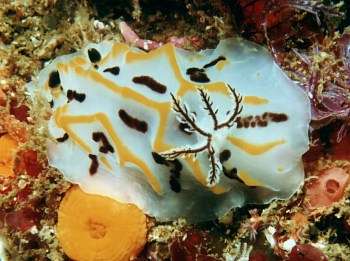
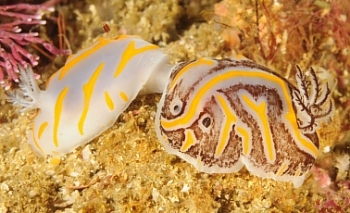
Halgerda dichromis
Fahey & Gosliner, 1999
Order: NUDIBRANCHIA
Suborder: DORIDINA
Superfamily: EUDORIDOIDEA
Family: Dorididae
DISTRIBUTION
South Africa, (east coast)
PHOTO
Upper: South Coast KwaZulu-Natal, South Africa. Near Port Shepstone. Rocky reef - 20m., October 1999. Size: 50 mm. Lower: Park Rynie, KwaZulu-Natal, 30 m, South Africa, 24 March 2009. Length: 30 mm. mating pair showing colour variation. Photos: Valda Fraser.
Described from a single specimen from South Africa it was previously figured in Gosliner, 1987 p.69 [no.89] as H. formosa. Fahey & Gosliner compare it with H. formosa and note that it differs externally in having indistinct ridges and both black and yellow-orange lines, as well as anatomical differences. It should also be compared with H. toliara. It also has similarities to H. willeyi but in that species the yellow lined ridges are much more numerous and there many fine black lines. More specimens are needed to see just what colour variation is found in this species.
Note added March 2009: Fahey & Gosliner (2003) confirm the photos above are all colour variants of H. dichromis.
Compare with:
•H. willeyi - yellow reticulate pattern, many black lines - no black spots around mantle edge.
•H. formosa (Bergh, 1880) - yellow reticulate pattern - some black spotting around mantle skirt, and small whitish pustules near edge.
•H. toliara Fahey & Gosliner, 1999. - yellow reticulate pattern - no black spots on mantle, small yellow pustules near edge.
-
Fahey, S. & Gosliner, T.M. (1999) description of three new species of Halgerda from the western Indian Ocean, with a redescription of Halgerda formosa, Bergh, 1880. Proceedings of the California Academy of Sciences, 51(8): 365-383.
-
Fahey, S. J. & Gosliner, T. M. (2003) Redescription of Halgerda graphica Basedow and Hedley,1905, with observations on external morpohological variation within selected species of Halgerda (Mollusca: Nudibranchia). Proceedings of the California Academy of Sciences, 54, 393-406.
-
Gosliner, T. (1987) Nudibranchs of Southern Africa. Sea Challengers: Monterey
-
Rudman, W.B. (1978) The dorid opisthobranch genera Halgerda and Sclerodoris from the Indo-West Pacific. Zoological Journal of the Linnean Society 62: 59-88.
Rudman, W.B., 1999 (November 18) Halgerda dichromis Fahey & Gosliner, 1999. [In] Sea Slug Forum. Australian Museum, Sydney. Available from http://www.seaslugforum.net/find/halgdich
Related messages
Colour forms of Halgerda dichromis mating
March 31, 2009
From: Valda Fraser
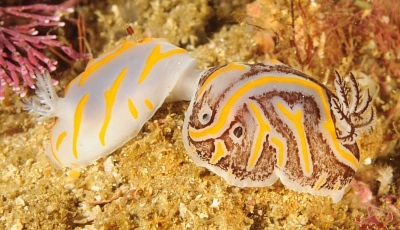
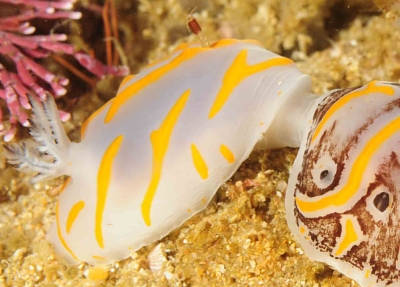
Dear Bill
Today was a lucky day, except for a current from hell! I found two variant forms of Halgerda dichromis mating. "Regular-looking" specimens were visible in the near vicinity.
Best wishes
Valda
Locality: Park Rynie< KwaZulu-Natal, 30m, South Africa, Indian, 24 March 2009, Rocky reef. Length: 30mm. Photographer: Valda Fraser.
valdafraser@mweb.co.za
Fraser, V. J., 2009 (Mar 31) Colour forms of Halgerda dichromis mating. [Message in] Sea Slug Forum. Australian Museum, Sydney. Available from http://www.seaslugforum.net/find/22362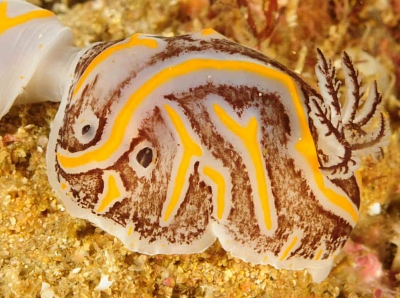
Dear Valda,
I am so glad your were decided to brave the 'current from hell'. Halgerda dichromis was based on a single species similar in colour to the Fact Sheet photo [message #1541] so I found it quite difficult to identify other coloured animals with this species - and felt quite brave in suggesting your brownish specimen [message #2053] could be the same species. Fortunately Fahey & Gosliner (2003) later studied the anatomy of it and the animal in your message #2679 and could find no anatomical differences. Your find of these two animals mating is an excellent confirmation of the colour variability to be found in this species.
It does of course raise the question of whether Halgerda theobroma from western Australian coast of the Indian Ocean is the same species?
-
Fahey, S. J. & Gosliner, T. M. (2003) Redescription of Halgerda graphica Basedow and Hedley,1905, with observations on external morpohological variation within selected species of Halgerda (Mollusca: Nudibranchia). Proceedings of the California Academy of Sciences, 54, 393-406.
Best wishes,
Bill Rudman
Halgerda toliara? from Madagascar
January 20, 2001
From: Leif Abrell
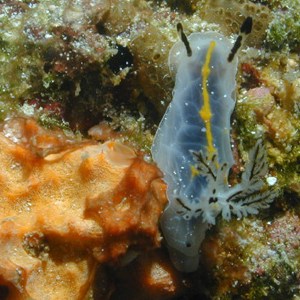
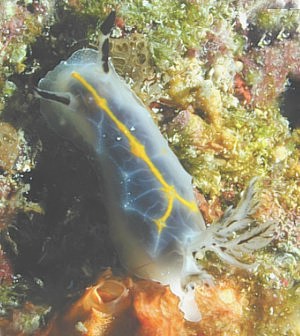
Dear Dr. Rudman and forum participants:
I would like to share my photos of a nudibranch I photographed underwater on a sponge/rock substrate approximately 10 meters deep in NW Madagascar in April, 2000. I've spent a fair amount of time looking at nudibranch pictures in order to make a tentative id. The closest match I can make so far, is to the Halgerda toliara photos posted on the Sea Slug Forum. I look forward to receiving anyone's ideas about the identification of this nudibranch.
I am a bioorganic natural products chemist doing post doctoral work in the Chemistry Dept. at Columbia University in NYC. I am interested in marine invertebrate natural products, including the chemistry of opisthobranchs. I have photos of a few other nudibranchs from Madagascar which I will send to the Forum. They can be seen at http://www.columbia.edu/~la202/Mad-opisth2000.html
Leif Abrell
lagartica@hotmail.com
Abrell, L., 2001 (Jan 20) Halgerda toliara? from Madagascar. [Message in] Sea Slug Forum. Australian Museum, Sydney. Available from http://www.seaslugforum.net/find/3569Dear Leif,
I think your Halgerda is a bit of a problem. Unfortunately a number of species have recently been described from very few, in some cases only one, specimen. This means we have little idea of their colour variability. For example Halgerda dichromis was described from a single specimen and one of its chracteristics was that it lacked the ridges found in most species of Halgerda. However from the photos we now have from Valda Fraser it seems that this species is quite variable and it can have quite pronounced ridges.
Which gets me in a round about way to your animal. It certainly looks like Halgerda toliara, which also seems fairly variable in colour, and was originally described from Madagascar, but the colour of the gills and rhinophores are different. In your animal the rhinophore club is apparently black and the white stalk has a black line up the posterior midline. The dorsal side of the gills is lined with black. In 'typical' H. toliara there is no black line on the rhinophore stalk and the distal half of each gill seems to be all black. Your animal has some similarities to Halgerda formosa, but there is no sign of black spots on the mantle.
My feeling is that it might be a colour form of Halgerda dichromis. The gill and rhinophore colour fits, and in Valda's photos [see messages below yours on this page] the yellow median line often forks posteriorly, sending a branch down each side of the gills. However this is just a guess. You may have another unnamed yellow and black species or you may just have a variation of a species we don't know very much about at present.
I look forward to any contributions you can make concerning nudibranchs and their chemicals. It is a fascinating field of study.
Best wishes,
Bill Rudman
Halgerda dichromis? from South Africa
August 8, 2000
From: Valda Fraser
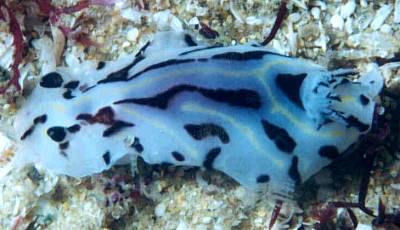
Dear Bill
Another variation of Halgerda dichromis perhaps? It looks a bit different!
Locality: Aliwal Shoal, Umkomaas, KwaZulu-Natal, SOUTH AFRICA - 15m
Date: July 2000
Size: 30mm
Regards
Valda Fraser
iti04937@mweb.co.za
Fraser, V., 2000 (Aug 8) Halgerda dichromis? from South Africa. [Message in] Sea Slug Forum. Australian Museum, Sydney. Available from http://www.seaslugforum.net/find/2822Dear Valda,
Yes I think this is probably Halgerda dichromis.
Bill Rudman.
A variety of Halgerda dichromis?
July 10, 2000
From: Valda Fraser
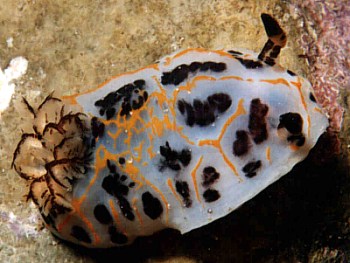
Dear Bill
Diving in the colder waters of the Transkei I only saw this kind of Halgerda, and lots of them. Do you think it is yet another variation of Halgerda dichromis?
Locality: Brazen Head, Transkei, SOUTH AFRICA - 28m
Date: June 2000
Size: 35mm
Regards
Valda
iti04937@mweb.co.za
Fraser, V., 2000 (Jul 10) A variety of Halgerda dichromis?. [Message in] Sea Slug Forum. Australian Museum, Sydney. Available from http://www.seaslugforum.net/find/2679Dear Valda,
With the proviso that the anatomy would need to confirm it, agree with your that this is probably a colour form of H. dichromis
Best wishes,
Bill Rudman.
Halgerda dichromis from South Africa
March 12, 2000
From: Valda Fraser
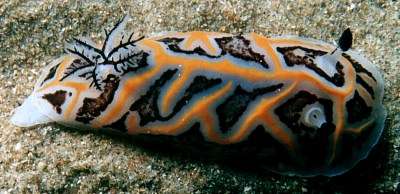
Dear Bill
I think this is a Halgerda, but none of the illustrations in the Species List match my photo. HELP!
Locality: South Coast KwaZulu-Natal, South Africa. Shelly Beach (near Port Shepstone)- 36m
Date: 5 March 2000
Size: 45mm
Regards
Valda Fraser
iti04937@mweb.co.za
Fraser, V., 2000 (Mar 12) Halgerda dichromis from South Africa. [Message in] Sea Slug Forum. Australian Museum, Sydney. Available from http://www.seaslugforum.net/find/2053Dear Valda,
I know we are in unchartered waters here but I think this is a colour form of Hlagerda dichromis. I know it looks a bit different from the photos we already have on the site but with a bit more dark brown/black they would be quite like this.
H. dichromis was described from a single specimen so it is only your material that is giving us any indication of the colour range within the species. Any further colour variations would be interesting, especially internediates between this colout form and the earlier ones.
Best wishes,
Bill Rudman.
Re: Halgerda dichromis
December 1, 1999
From: Valda Fraser
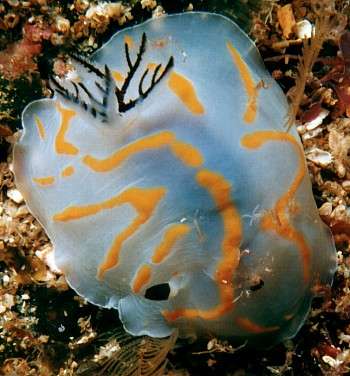
Dear Bill
You suggested that this animal may be a variation of Halgerda dichromis or possibly, another species altogether. I have found another one. This makes me think that your second suggestion is more plausible.
Locality: South Coast KwaZulu-Natal, SOUTH AFRICA. Scottburgh - 28m, 28 November 1999
Size: 40mm.
Look at all the shrimps on the poor thing!
Regards
Valda Fraser
iti04937@mweb.co.za
Fraser, V., 1999 (Dec 1) Re: Halgerda dichromis. [Message in] Sea Slug Forum. Australian Museum, Sydney. Available from http://www.seaslugforum.net/find/1621Dear Valda,
It wasn't this colour form I thought was possibly different but the one on the bottom left of your message with the more yellow lines and more sharply angled complete ridges. But perhaps all three in that message are different. Now that you are aware that such differences could be significant you will develop an instinct for noticing them. Internal anatomy is the best way to be sure if two animals are different, but we can't cut up every animal we see. Keep an eye out for egg laying, mating, - any little biological activity which might be a useful clue to differences.
Concerning the shrimps crawling over its back - you certainly seem to be in an area rich in crustacea. It looks like they have just hopped on as the slug has crawled through their territory rather than being commensals.
Best wishes,
Bill Rudman.
Colour variation in Halgerda dichromis
November 24, 1999
From: Valda Fraser
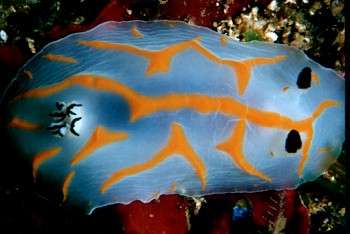
Dear Bill
To answer your question about colour variation, to date all specimens of Halgerda dichromis I have seen have seemed very similar in colour. Over the weekend, however, I saw a specimen that has made me stop to think. This one has no black spots. Are they just missing, or is this another kind of Halgerda?
I also wonder if it is possible for this nudibranch to adapt its colour to the immediate environment - like a chameleon. I ask this as I have noticed that when the animal is on sand it is less vividly coloured. Refer to the two lower photos for comparison.
You will note that the pair in the lower right photo are mating.
Locality: South Coast KwaZulu-Natal, SOUTH AFRICA. Scottburgh / near Port Shepstone.
UPPER RIGHT: 60mm long, 24m depth,
LOWER LEFT: 55m long, 36m depth,
LOWER RIGHT: 50mm long, 20m depth.
Date: October - November 1999
Regards
Valda Fraser
iti04937@mweb.co.za
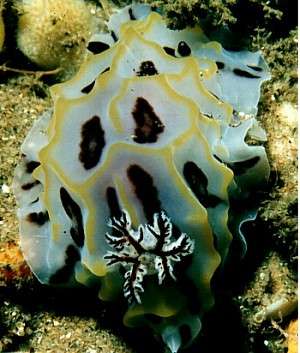
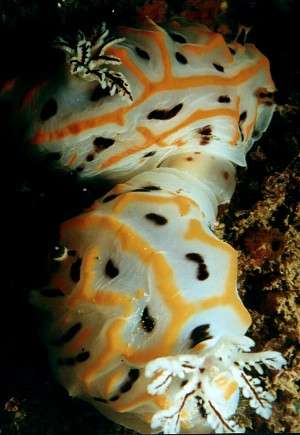
Dear Valda,
This is certainly the sort of colour variation I was hoping for. The orange lines in the upper photo look very like those illustrated by Fahey & Gosliner, although your specimen lacks any black lines. The other two photos, and your first photo seem to suggest the three are the same species.
Very few sea slugs have been reported to show any chameleon-like ability to change colour although some can gradually change colour if their colour is derived from food pigmentation. The difference in the yellow/orange colour may be genetic or it is possible that it could be a food-based pigment from their sponge food. If the sand-dwelling ones are feeding on a less intensely coloured sponge than the rock dwelling ones then I guess a locality related colour difference could develop. But I have no evidence to back that up.
The other possibility is that the yellowish animal (lower left) is another species. It definitely has more complete ridges than the orange lined animals, looking more like Halgerda formosa in shape, if not in colour.
All very interesting,
Best wishes,
Bill Rudman.
Halgerda dichromis? from South Africa
November 19, 1999
From: Valda Fraser

Dear Bill
Thank you for your reply. You are right in saying that the specimen is not Halgerda formosa which is very common in our area. I am afraid that my identification of Halgerda formosa is not correct. Please confirm that the photo which I am attaching is Halgerda formosa because it seems to be very different in colouration and body texture from the image of Halgerda toliara.
Locality: South Coast KwaZulu-Natal, SOUTH AFRICA. Near Port Shepstone. Rocky reef - 20m., October 1999. Size: 50mm
Regards
Valda Fraser
iti04937@mweb.co.za
Fraser, V., 1999 (Nov 19) Halgerda dichromis? from South Africa. [Message in] Sea Slug Forum. Australian Museum, Sydney. Available from http://www.seaslugforum.net/find/1541Dear Valda,
The plot thickens! This photo is not H. formosa and certainly not H. toliara. It looks something like a badly striped Halgerda willeyi but I think the most likely identification is another new species described by Fahey & Gosliner, Halgerda dichromis. It is the animal figured in Gosliner, 1987 p.69 [no.89] and misidentified as H. formosa. Your photo differs in having much shorter black lines than in Gosliner's photo but as they had only one specimen, it will need more specimens to be sure just how variable the colour pattern of the species is. You say this is common in your area. Perhaps you could send some more photos showing the range of any colour variation.
I would welcome any thoughts from Shireen Fahey & Terry Gosliner.
Best wishes,
Bill Rudman.
